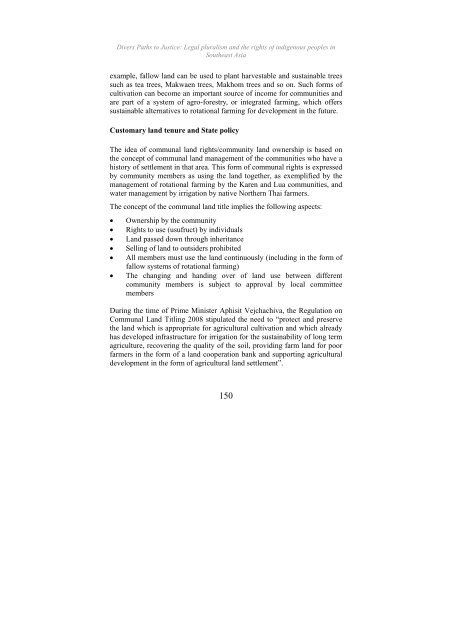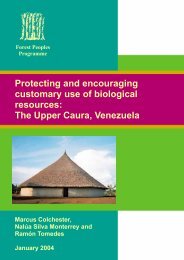Divers Paths to Justice - English - Forest Peoples Programme
Divers Paths to Justice - English - Forest Peoples Programme
Divers Paths to Justice - English - Forest Peoples Programme
You also want an ePaper? Increase the reach of your titles
YUMPU automatically turns print PDFs into web optimized ePapers that Google loves.
<strong>Divers</strong> <strong>Paths</strong> <strong>to</strong> <strong>Justice</strong>: Legal pluralism and the rights of indigenous peoples inSoutheast Asiaexample, fallow land can be used <strong>to</strong> plant harvestable and sustainable treessuch as tea trees, Makwaen trees, Makhom trees and so on. Such forms ofcultivation can become an important source of income for communities andare part of a system of agro-forestry, or integrated farming, which offerssustainable alternatives <strong>to</strong> rotational farming for development in the future.Cus<strong>to</strong>mary land tenure and State policyThe idea of communal land rights/community land ownership is based onthe concept of communal land management of the communities who have ahis<strong>to</strong>ry of settlement in that area. This form of communal rights is expressedby community members as using the land <strong>to</strong>gether, as exemplified by themanagement of rotational farming by the Karen and Lua communities, andwater management by irrigation by native Northern Thai farmers.The concept of the communal land title implies the following aspects:• Ownership by the community• Rights <strong>to</strong> use (usufruct) by individuals• Land passed down through inheritance• Selling of land <strong>to</strong> outsiders prohibited• All members must use the land continuously (including in the form offallow systems of rotational farming)• The changing and handing over of land use between differentcommunity members is subject <strong>to</strong> approval by local committeemembersDuring the time of Prime Minister Aphisit Vejchachiva, the Regulation onCommunal Land Titling 2008 stipulated the need <strong>to</strong> “protect and preservethe land which is appropriate for agricultural cultivation and which alreadyhas developed infrastructure for irrigation for the sustainability of long termagriculture, recovering the quality of the soil, providing farm land for poorfarmers in the form of a land cooperation bank and supporting agriculturaldevelopment in the form of agricultural land settlement”.150
















